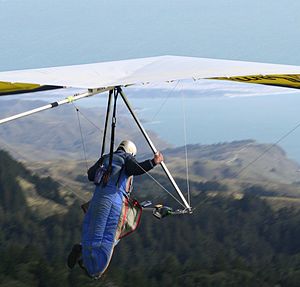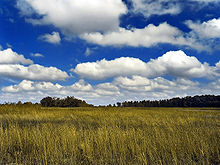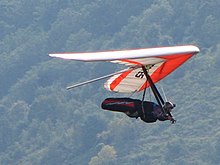Hang gliding
| Hang gliding | ||||||||||||||||||
|---|---|---|---|---|---|---|---|---|---|---|---|---|---|---|---|---|---|---|

| ||||||||||||||||||
| Hang glider launching from Mount Tamalpais | ||||||||||||||||||
|
||||||||||||||||||
| Supported by LTA gases + aerodynamic lift | ||||||||||||||||||
|
||||||||||||||||||
| Supported by aerodynamic lift (aerodynes) | ||||||||||||||||||
|
||||||||||||||||||
| Other means of lift | ||||||||||||||||||
|
||||||||||||||||||
Hang gliding is an air sport in which a pilot flies a light and unmotorized foot-launchable aircraft called a hang glider. Most modern hang gliders are made of an aluminum or composite frame with a fabric wing. Pilots usually control the aircraft by shifting body weight, but other devices, including modern aircraft flight control systems, may be used. The pilot wears a harness and is hung beneath a lifting wing by flexible straps.
In the sport's early days, pilots were restricted to gliding down small hills on low-performance hang gliders. However, modern technology gives pilots the ability to soar for hours, gain thousands of feet of altitude in thermal updrafts, perform aerobatics, and fly cross-country for hundreds of miles. The Fédération Aéronautique Internationale and national airspace governing organizations control some aspects of hang gliding.
History
Early forms of gliding had existed in China perhaps by the 4th century AD according to the writing of the Daoist Ge Hong, and certainly by the time of Emperor Wenxuan of Northern Qi (r. 550–559 AD) who used men sentenced to death as test pilots for his man-flying kites launched from a tower.[1] Some hang glider flights have been recorded in 875 AD, when Abbas Ibn Firnas attempted a flight in Al-Andalus.[2]
In 1010 the monk Eilmer of Malmesbury constructed a rudimentary form of glider, and flew from the tower of Malmesbury Abbey for 200 metres before landing, breaking both his legs. He was going to make another attempt at flying, adding a tail for great control in flight, but the Abbot forbade him risking his life in any further experiments.
Most early glider designs did not ensure safe flight; the problem was that early flight pioneers did not understand the underlying principles that made a bird's wing work. Starting in the 1880s technical and scientific advancements were made that led to the first truly practical gliders. Otto Lilienthal of Germany duplicated some of his contemporaries' work and greatly expanded on it from 1874. He rigorously documented his work, strongly influencing later designers; for this reason, Lilienthal is one of the best known and most influential early aviation pioneers. His type of aircraft is now known as a hang glider.
In 1951 Francis Rogallo and Gertrude Rogallo applied for a patent for a fully flexible wing with approved claims for its stiffenings and gliding uses, the flexible wing or Rogallo wing, which in 1957 the American space agency NASA began testing in various flexible and semi-rigid configurations in order to use it as a recovery system for the Gemini space capsules. It was designer engineer Charles Richards directed by Paul Bikle who showed how to build the wing.
The various stiffening formats and the wing's simplicity of design and ease of construction, along with its capability of slow flight and its gentle landing characteristics, did not go unnoticed by hang glider enthusiasts. In 1960-1962 Barry Hill Palmer adapted the flexible wing concept to make foot-launched hang gliders with four different control arrangements. In 1963 Mike Burns adapted the flexible wing to build a kite-hang glider he called Skiplane. In 1963, John W. Dickenson adapted the flexible wing airfoil concept to create the most popular hang glider format to date. For this, the Fédération Aéronautique Internationale vested Dickenson with the Hang Gliding Diploma (2006) for the invention of the modern hang glider.[3]
Training and safety

Since its inception, hang gliding has traditionally been considered an unsafe sport. Modern hang gliders are very sturdy when constructed by HGMA, BHPA, DHV or other certified standards and using modern materials, though they remain lightweight craft that can be easily damaged, either through misuse or by continued operation in unsafe wind/weather conditions. All modern gliders have built-in stall recovery mechanisms such as luff lines in kingposted gliders. Nevertheless, the inherent danger of gliding at the mercy of thermal and wind currents, has resulted in numerous fatal accidents and many serious injuries over the years, even to experienced pilots, and the resultant adverse publicity has affected the popularity of hang gliding.
As a backup, pilots carry a parachute in the harness. In case of serious problems the parachute is deployed and carries both pilot and glider down to earth. Pilots also wear helmets and generally carry other safety items such as hook knives (for cutting their parachute bridle after impact or cutting their harness lines and straps in case of a tree or water landing), light ropes (for lowering from trees to haul up tools or climbing ropes), radios (for calling for help) and first-aid equipment.
The accident rate from hang glider flying has been dramatically improved by pilot training. Early hang glider pilots learned their sport through trial and error. Training programs have been developed for today's pilot, with emphasis on flight within safe limits, as well as the discipline to cease flying when weather conditions are unfavorable, for example: excess wind or risk cloud suck.
Launch
Launch techniques include foot-launching from a hill, tow-launching from a ground-based tow system, aerotowing (behind a powered aircraft), powered harnesses, and being towed up by a boat. Modern winch tows typically utilize hydraulic systems designed to regulate line tension, this reduces scenarios for lock out as strong winds result in additional length of rope spooling out rather than direct tension on the tow line. Other more exotic launch techniques have also been used successfully, such as hot air balloon drops for very high altitude. Flights in non-soarable conditions are referred to as "sled runs".
Soaring flight and cross-country flying


A glider is continuously "falling" through the air yet glider pilots can stay airborne for hours. Once this skill has been mastered, pilots can glide long distances to fly cross-country (XC). Sustained flight is made possible by rising air masses (which provide lift) from the following sources:
- Thermals
- The most commonly used source of lift is created by the sun's energy heating the ground which in turn heats the air above it. This warm air rises in columns known as thermals. Soaring pilots quickly become aware of land features which can generate thermals; and of visual indications of thermals such as soaring birds, cumulus clouds, cloud streets, dust devils, and haze domes. Also, nearly every glider contains an instrument known as a variometer (a very sensitive vertical speed indicator) which shows visually (and often audibly) the presence of lift and sink. Having located a thermal, a glider pilot will circle within the area of rising air to gain height. In the case of a cloud street thermals can line up with the wind creating rows of thermals and sinking air. A pilot can use a cloud street to fly long straight-line distances by remaining in the row of rising air.
- Ridge lift
- Ridge lift occurs when the wind meets a mountain, cliff or hill. The air is deflected up the windward face of the mountain, causing lift. Gliders can climb in this rising air by flying along the feature. Another name for flying with ridge lift is slope soaring.
- Mountain waves
- The third main type of lift used by glider pilots is the lee waves that occur near mountains. The obstruction to the airflow can generate standing waves with alternating areas of lift and sink. The top of each wave peak is often marked by lenticular cloud formations.
- Convergence
- Another form of lift results from the convergence of air masses, as with a sea-breeze front. More exotic forms of lift are the polar vortexes which the Perlan Project hopes to use to soar to great altitudes [4]. A rare phenomenon known as Morning Glory has also been used by glider pilots in Australia.[4]
Performance

With each generation of materials and with the improvements in aerodynamics, the performance of hang gliders has increased. One measure of performance is the glide ratio. For example, a ratio of 12:1 means that in smooth air a glider can travel forward 12 meters while only losing 1 meter of altitude.
Some performance figures as of 2006:
- Topless gliders (no kingpost): glide ratio ~17:1, speed range ~30 to >145 km/h, best glide at ~45 to 60 km/h
- Rigid wings: glide ratio ~20:1, speed range ~ 35 to > 130 km/h, best glide at ~50 to 60 km/h.
- Ballast
- The extra weight provided by ballast is advantageous if the lift is likely to be strong. Although heavier gliders have a slight disadvantage when climbing in rising air, they achieve a higher speed at any given glide angle. This is an advantage in strong conditions when the gliders spend only little time climbing in thermals.
Stability and equilibrium

Because hang gliders are most often used for recreational flying, a premium is placed on gentle behavior especially at the stall and natural pitch stability. The wing loading must be very low in order to allow the pilot to run fast enough to get above stall speed. Unlike a traditional aircraft with an extended fuselage and empennage for maintaining stability, hang gliders rely on the natural stability of their flexible wings to return to equilibrium in yaw and pitch. Roll stability is generally set up to be near neutral. In calm air, a properly designed wing will maintain balanced trimmed flight with little pilot input. The flex wing pilot is suspended beneath the wing by a strap attached to his harness. The pilot lies prone (sometimes supine) within a large, triangular, metal control frame. Controlled flight is achieved by the pilot pushing and pulling on this control frame thus shifting his weight fore or aft, and right or left in coordinated maneuvers.
- Roll
- Most flexible wings are set up with near neutral roll due to sideslip (anhedral effect). In the roll axis, the pilot shifts his body mass using the wing control bar, applying a rolling moment directly to the wing. The flexible wing is built to flex differentially across the span in response to the pilot applied roll moment. For example, if the pilot shifts his weight to the right, the right wing trailing edge flexes up more than the left, allowing the right wing to drop and slow down.
- Yaw
- The yaw axis is stabilized through the sweep back of the wings. The swept planform, when yawed out of the relative wind, creates more lift on the advancing wing and also more drag, stabilizing the wing in yaw. If one wing advances ahead of the other, it presents more area to the wind and causes more drag on that side. This causes the advancing wing to go slower and to fall back. The wing is at equilibrium when the aircraft is traveling straight and both wings present the same amount of area to the wind.
- Pitch
- The pitch control response is direct and very efficient. It is partially stabilized by the sweep of the wings. The wing center of gravity is close to the hang point and at the trim speed, the wing will fly "hands off" and return to trim after being disturbed. The weight-shift control system only works when the wing is positively loaded (right side up); To maintain a minimum safe amount of washout when the wing is unloaded or even negatively loaded (upside down), positive pitching devices such as reflex lines or washout rods are employed. Flying faster than trim speed is accomplished by moving the pilots weight forward in the control frame; flying slower by shifting the pilots weight aft (pushing out).
Furthermore, the fact that the wing is designed to bend and flex, provides favorable dynamics analogous to a spring suspension. This allows the wing to be less susceptible to turbulence and provides a gentler flying experience than a similarly sized rigid-winged aircraft.
Instruments
To maximize a pilot's understanding of how the hang glider is flying, most pilots carry instruments. The most basic being a variometer and altimeter—often combined. Some more advanced pilots also carry airspeed indicators and radios. When flying in competition or cross country, pilots often also carry maps and/or GPS units. Hang gliders do not have instrument panels as such, so all the instruments are mounted to the control frame of the glider or occasionally based on one's watch.
Variometer

Gliding pilots are able to sense the acceleration forces when they first hit a thermal, but have difficulty gauging constant motion. Thus it is difficult to detect the difference between constantly rising air and constantly sinking air. A variometer is a very sensitive vertical speed indicator. In other words, the variometer indicates climb rate or sink rate with audio signals (beeps) and/or a visual display. These units are generally electronic, vary in sophistication, and often include an altimeter and an airspeed indicator. More advanced units often incorporate a barograph for recording flight data and/or a built-in GPS. The main purpose of a variometer is in helping a pilot find and stay in the ‘core’ of a thermal to maximize height gain, and conversely indicating when he or she is in sinking air and needs to find rising air. Variometers are sometimes capable of electronic calculations based on the MacCready Speed Ring to indicate the optimal speed to fly for given conditions. The MacCready theory answers the question on how fast a pilot should cruise between thermals, given both the average lift the pilot expects in the next thermal climb, as well as the amount of lift or sink he encounters in cruise mode. Some electronic variometers make the calculations automatically, after allowing for factors such as the glider's theoretical performance (glide ratio), altitude, hook in weight and wind direction.

Radio
Pilots use radio for training purposes, and for communicating with other pilots in the air – particularly when traveling together on cross-country flights.
Radios used are PTT (push-to-talk) transceivers, normally operating in or around the FM VHF 2-metre band (144–148 MHz). Usually a microphone is incorporated in the helmet, and the PTT switch is either fixed to the outside of the helmet, or strapped to a finger. It should be emphasized that operating a 2-meter band radio without an appropriate Amateur Radio license is illegal in most countries (such as the United States) that have regulated airwaves.
GPS
GPS (global positioning system) is a necessary accessory when flying competitions, where it has to be demonstrated that way-points have been correctly passed.
It can also be interesting to view a GPS track of a flight when back on the ground, to analyze flying technique. Computer software is available which allows various different analyses of GPS tracks (e.g. CompeGPS).
Other uses include being able to determine drift due to the prevailing wind when flying at altitude, providing position information to allow restricted airspace to be avoided, and identifying one’s location for retrieval teams after landing-out in unfamiliar territory.
More recently, the use of GPS data, linked to a computer, has enabled pilots to share 3D tracks of their flights on Google Earth. This fascinating insight allows comparisons between competing pilots to be made in a detailed post-flight analysis.
Records
Records are sanctioned by the FAI. The world record(s) (as of 2005) for "free distance" is held by Manfred Ruhmer with 700.6 km (435.3 miles) in 2001 and Michael Barber flew a distance of 704 km (437 miles) on June 19, 2002 in Zapata Texas.[5]
Other records include:
Out-and-Return distance - 332.5 km (206.6 mi), July 5, 2007 by George Stebbins, starting and ending just South of Lone Pine, California.
Largest triangle - 357.12 km (221.9 mi), December 16, 2000 by Thomas Suchanek, starting and ending from Riverside Australia.
Competition
Competitions started with "flying as long as possible" and spot landings. With increasing performance cross-country flying replaced them. Usually two to four waypoints have to be passed with a landing at a goal. In the late 1990s low-power GPS units were introduced and have completely replaced photographs of the goal. Every two years there is a world championship. The Rigid and Women's World Championship in 2006 was hosted by Quest Air in Florida. Big Spring, Texas hosted the 2007 World Championship. Hang gliding is also one of the competition categories in World Air Games organized by Fédération Aéronautique Internationale (World Air Sports Federation - FAI), which maintains a chronology of the FAI World Hang Gliding Championships.[6]
Classes

For competitive purposes, there are three classes of hang glider:
- The flexible wing hang glider, having flight controlled by a wing whose shape changes by virtue of the shifted weight of the pilot. This is not a paraglider.
- The rigid wing hang glider, having flight controlled by spoilers, typically on top of the wing. In both flexible and rigid wings the pilot hangs below the wing without any additional fairing.
- Class 2 (designated by the FAI as Sub-Class O-2) where the pilot is integrated into the wing by means of a fairing. These offer the best performance and are the most expensive.
In addition to typical launch configurations, a hang glider may be so constructed for alternative launching modes other than being foot launched; one practical avenue for this is for people who physically cannot foot-launch.[7]
Comparison of gliders, hang gliders and paragliders
There is sometimes confusion between gliders, hang gliders and paragliders. In particular paragliders and hang gliders are both foot-launched aircraft. The main differences between the types are:
| Paragliders | Hang gliders | Gliders/Sailplanes | |
|---|---|---|---|
| Undercarriage | pilot's legs used for take-off and landing | pilot's legs used for take-off and landing | aircraft takes off and lands using a wheeled undercarriage or skids |
| Wing structure | entirely flexible, with shape maintained purely by the pressure of air flowing into and over the wing in flight and the tension of the lines | generally flexible but supported on a rigid frame which determines its shape (note that rigid-wing hang gliders also exist) | rigid wing surface which totally encases wing structure |
| Pilot position | sitting in a harness | usually lying prone in a cocoon-like harness suspended from the wing; seated and supine are also possible | sitting in a seat with a harness, surrounded by a crash-resistant structure |
| Speed range (stall speed – max speed) |
slowest – typically 25 to 60 km/h for recreational gliders (over 50 km/h requires use of speed bar),[8] hence easier to launch and fly in light winds; least wind penetration; pitch variation can be achieved with the controls | faster than paragliders, slower than gliders/sailplaines | maximum speed up to about 280 km/h (170 mph);[9] stall speed typically 65 km/h (40 mph);[9] able to fly in windier turbulent conditions and can outrun bad weather; good penetration into a headwind |
| Maximum glide ratio | about 10, relatively poor glide performance makes long distance flights more difficult; current (as of May 2017[update]) world record is 564 kilometres (350 mi)[10] | about 17, with up to 20 for rigid wings | open class sailplanes – typically around 60:1, but in more common 15–18 meter span aircraft, glide ratios are between 38:1 and 52:1;[11] high glide performance enabling long distance flight, with 3,000 kilometres (1,900 mi) being current (as of November 2010[update]) record[12] |
| Turn radius | tightest turn radius[citation needed] | somewhat larger turn radius than paragliders, tigher than gliders/sailplanes[citation needed] | widest turn radius but still able to circle tightly in thermals[13] |
| Landing | smallest space needed to land, offering more landing options from cross-country flights; also easiest to pack up and carry like a bag to the nearest road | 15 m to 60 m length flat area required; can be derigged by one person and carried to the nearest road | landings can be performed in ~250 m length field. Aerial retrieve may be possible but if not, specialized trailer needed to retrieve by road. Some sailplanes have engines that remove the need for an out-landing, if successfully started on time |
| Learning | simplest and quickest to learn | teaching is done in single and two-seat hang gliders | teaching is done in a two-seat glider with dual controls |
| Convenience | packs smaller (easier to transport and store) | more awkward to transport and store; longer to rig and de-rig; often transported on the roof of a car | often stored and transported in purpose-built trailers about 9 metres long, from which they are rigged. Although rigging aids allow a single person to rig a glider, usually the rigging involves 2 or 3 people. Some frequently used sailplanes are stored already rigged in hangars. |
| Cost | cost of new is €1500 and up,[14] cheapest but shortest lasting (around 500 hours flying time, depending on treatment), active second-hand market[15] | cost of new glider very high (top of the range 18 m turbo with instruments and trailer €200,000) but it is long lasting (up to several decades), so active second-hand market; typical cost is from €2,000 to €145,000[16] |
References
- ^ Temple, Robert. (1986). The Genius of China: 3,000 Years of Science, Discovery, and Invention. With a forward by Joseph Needham. New York: Simon and Schuster, Inc. ISBN 0671620282. Page 175–176.
- ^ Abbas Ibn Firnas' flights in year 875 near Cordoba, Spain (Ibn Firnas crater on the Moon is named in his honor).
- ^ FAI Award: The FAI Hang Gliding Diploma
- ^ A Guide to the Morning Glory at www.dropbears.com
- ^ Mike Barber needed to fly 1% further than Ruhmer's 435 miles (700 km) in order to break the official FAI record; Barber needed to fly only 3 more miles for a total of 440 miles (710 km). Barber's flight remains the longest hang glider flight ever.
- ^ Chronology of the FAI World Hang Gliding Championships[1]
- ^ Dan Buchanan: [2]
- ^ "Technical data for Advance Omega 8". Advance AG. Archived from the original on 2013-05-30. Retrieved 2011-10-22.
- ^ a b Flight Manual of Scheicher ASW27b. Alexander Schleicher GmbH & Co. 2003.
- ^ "FAI Paragliding record". Fédération Aéronautique Internationale. Archived from the original on 2011-05-09. Retrieved 2010-11-30.
- ^ "Handicap list 2008" (PDF). Deutsche Meisterschaft im Streckensegelflug. Deutscher Aero Club. Archived from the original (PDF) on 2009-02-24. Retrieved 2008-08-07.
- ^ "FAI records". Fédération Aéronautique Internationale. Archived from the original on 2011-09-11. Retrieved 2010-11-30.
- ^ Stewart, Ken (1994). The Glider Pilot's Manual. Airlife Publishing Ltd. p. 257. ISBN 1-85310-504-X.
- ^ "Brochures Ozone". Ozone France. Archived from the original on 2013-10-27. Retrieved 2011-10-21.
- ^ "Typical set of classified ads for paragliders". Archived from the original on 2012-03-30. Retrieved 2011-10-22.
- ^ "Typical set of classified ads for gliders". Archived from the original on 2010-12-06. Retrieved 2011-01-18.
Related sports
- Gliding
- Paragliding
- Microlift gliding
- Powered paragliding
- Powered hang gliding
- Comparison with gliders and paragliders
